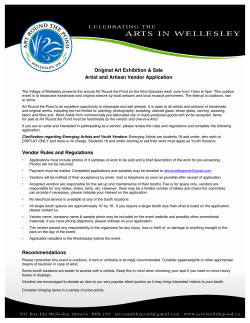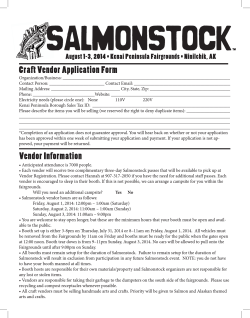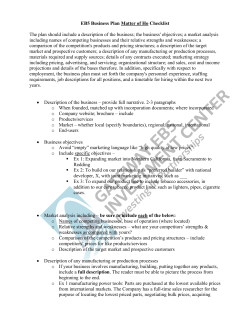
How to Select Support Desk Software
How to Select Support Desk Software With over 100 Support Desk vendors in the market, prices ranging from free to over $5,000 per advanced user (i.e. Technical Support Rep or Customer Support Rep) and an overwhelming array of architectures, web services and features to evaluate, selecting the right Support Desk for your organization can be a time consuming and frustrating process. The purpose of this document is to try and simplify the process for you. This white paper will address common issues that everyone in the Support Desk Market should understand prior to making a final selection. Understanding these issues will help you make a more informed decision. Architecture The issue that tends to cause the most confusion in our industry is client/server Web enabled solutions (C/S) vs. 100% Web based solutions. In general, C/S architected solutions are a dying breed. At one point, an excellent improvement over main frame solutions, C/S technology has been phased out due to the availability and advantages of Web based solutions. The main reason some vendors continue to sell C/S solutions is due to the fact that they do not have the development resources to convert their older product to a Web based architecture. Some of the advantages that Web based solutions have over C/S solutions include: No client-side software installation, updates or support Log in from anywhere, anytime with any browser Full access to all features and functions anytime and from anywhere When you begin to demo different solutions please take note if you are required to load code on your desktop to begin the demo. If so, you are not dealing with a vendor that offers a Web based solution. True Web based architectures need only a URL in order to see a demo. So, if the vendor sends you a 5 MB .exe file to demo their solution, you are not seeing a 100% Web based solution. The file that vendor is sending you is either front ending a C/S system or is a complete “canned” demo on your desktop. Make sure you evaluate the solution you are going to be purchasing! If you do purchase a C/S solution, please note that Web enabled add-on modules will not give you full access to all of the features when you are at a remote location. Pricing, Terms & Conditions, and Hosting When obtaining pricing information, the key is to get a detailed quote. Vendors seeking to entice prospects with low costs may only provide summary quotes. These summary quotes may not include features that are not a part of the core solution (add-on modules), but may be required by you for your specific support desk needs. For example, a vendor may tell you that their solution supports Active Directory (AD) and SQL Server, but when you receive a summary quote, it may only reflect the price of the core solution. You may later find out, after purchasing the solution, that AD is one of their add-on modules. You will then need to purchase this add-on functionality, driving the total price up much higher than you anticipated. When requesting a price quote: Specifically point out what you require and make sure that what you saw in the demo is what will be quoted. Ask for a price sheet that lists the vendors full range of solutions and add-on modules, so as your needs change you will not suffer from sticker-shock when it comes time to add more functionality and features. Solutions that offer standard, professional and enterprise versions can be very confusing and it is difficult to tell what features you are getting. Many vendors offer multiple versions but only have a single demo: How do you know exactly what you are getting? Choose incorrectly and your budget takes another hit to upgrade to the better version. Pricing should be published, clear and linear with no break points or multiple versions. Linear pricing allows you to pay only for what you need. Why should you purchase an 8-user Active Directory module if you only have five users? Linear pricing allows you to pay for the level of functionality you are using today with a very clear path as to what each additional user will cost. In addition, always ask for a money back guarantee. If what you install is different than what you thought you purchased, any reputable vendor should solve the problem or be happy to refund your money. Non-Specific User Permissions Can Lead To More Price Confusion A Support Desk Solution vendor should also clearly define user permissions. For example, Advanced users (i.e. an agent, tech, or CSR) and standard End users of the solution will have different permissions. The cost of an Advanced user license and the permissions included should be spelled out very clearly, as it is easy to get trapped into expensive upgrades when vendors do not make advanced and end user permissions very clear. Hosted Pricing Do you require a hosted solution or will you run the solution on your server? “On-demand” pricing for hosted support desk solutions is becoming the accepted model in the industry today. Pay only for what you use and only for as long as you need it. Look for vendors that require no long-term contracts. If a vendor is confident in the solution they provide, they will not require a long-term contract. Customer Support and Training Support options also generate confusion with many customers and should be clearly understood up front (again, customer references are always the best way to judge post sale support). It does not make sense for there to be more than one support option. For many vendors, Level 1 is usually a college student that reads the manual to you prior to putting you in a queue for second line support. The last thing you should hear from a vendors’ support staff is “this appears to be a Microsoft problem, give them a call.” Also, if you have a critical problem, support should be available 24 hours a day at no additional charge. If a customer has a problem, it needs to be addressed immediately and with the least amount of frustration and productivity loss. The educational offerings and training from a vendor also provide significant insight into the ease of use and ease of installation for a support desk solution. Training charges can be a very lucrative side business for vendors. How can a vendor claim ease-of-use and the ability to be up-and-running in less then eight hours if they suggest you attend a three day training class? Product Development, Releases and Packaging Consistent feature releases will tell you a lot about how quickly you can expect improvements and fixes. No matter how closely you pick your solution, you will find features you want changed or enhanced. Waiting two years for the next release with your requested features is not an acceptable situation. A good question to ask is: What percent of the vendor’s employees are working on development and support vs. sales and marketing? It is also critical to understand how the software is packaged, including add-on modules. All but the smallest vendors offer them and for good reason. You do not want to pay for functionality you do not need. For example, if you support external customers vs. internal employees, the odds are you do not need asset management, so why pay for it? Many vendors offer modules that look great on paper but are not fully integrated with the solution. You should require tight integration or look elsewhere. Extensibility A best of breed solution offers extensibility. For example, if you purchase a solution today to address IT issues, and later your CEO wants you to also address customer issues, what are the ramifications? Do you need a new and separate solution, or can your support desk solution be extended to other audiences. It is very important to understand the different requirements for these two groups of users. Users outside your organization require different security criteria, privacy attributes and most likely will need to take advantage of Web based self-registration and will most certainly require zero code installation on their work station. Make sure the solution you choose can service both customers and employees with a unique multi-organizational feature. You should not need a separate solution or infrastructure to track external or internal issues. Other Considerations If Sarbanes-Oxley, HIPAA, or the Gramm-Leach-Bliley Act affects your industry, then it will probably affect your solution selection as well. You need to understand how your vendor solution addresses these requirements. Vendor reputation, customer base and financial stability are all key factors in your decision to buy software. Do they have a solid financial base and can they prove it? Are they for sale or have they been recently acquired? How will these events affect the future of the solution? Why are they selling or why did they acquire the solution? How many customers are actively using the solution and are their profiles similar to yours? If a large sector of the Fortune 500 has purchased this particular solution, there is a better chance that other organizations have done the required due diligence for you to have a high confidence level in that vendor’s solution. Is source code availability a factor? It provides significant protection, should the vendor go bankrupt, and provides extensive capability to modify the solution to your exact requirements. Look for a vendor that offers source code for free and has extensive experience assisting customers in doing their own unique modifications while continuing to let the customer stay on the solution upgrade path. Here are some important features needed to run a successful Support Desk: Automatic Support Email Notification Streamline your support and service desk and speed communications by automatically e-mailing the appropriate person or group when: A new issue is submitted An issue is assigned An issue is updated with a note or question An issue is escalated An issue is closed Powerful Search Functionality A powerful search facility that allows users and technicians to search for issues based on: Who submitted the issue The department that submitted the issue Who the issues assigned to Projects Issue types Date opened and closed Location, office, business unit Project categories Keywords Asset Management Gathers hardware and software information about a user’s machine and automatically sends the data back to IssueTrak via HTTP. An excellent tool for software license compliance, initial and ongoing audits, financial control, financial planning and budgeting information, faster problem resolution and detailed management reporting. Active Directory Support This feature eliminates the need for separate user databases by using Active Directory, which authenticates IssueTrak against Active Directory and synchronizes data. Automatic Incoming Email Conversion End-users can report a problem by sending an email to a mailbox such as support@company.com. Automatic Email Conversion parses out relevant data from incoming end user emails and enters issues into the system as track able issues. The system also associates the emails with appropriate users and asset records. Change Management A change manager allows you to effectively manage the process of change management. You have the ability to: Implement your change processes Capture and complete the required documentation Notify and request approval from the appropriate personnel Remind those involved and track the resulting process through to completion Customizable System Options Define how you would like the system to work for you. Take advantage of over 50 user and system options. Detailed Management Reporting Run a variety of detailed reports related to management, strategic decision-making, and allocation of resources, software compliance, financial reporting, and audits. Groups Create groups, place users into the groups, and assign user attributes or issues to the group. Handles Multiple Locations Roll the solution out effortlessly to remote locations and customers. Provide national or international service from a single point! Highly Scalable Designed from the ground up to be inarguably the fastest Help Desk solution in the industry. Performance optimized page layouts No client-side ActiveX controls Microsoft's SQL Server (7.0 or above) Extensive use of stored procedures Search Pop Up technology Multi-Server Environment Hours of Operation Input your organization’s hours of operation in to a simple form and your data will automatically be adjusted to account for nights, weekends, and holidays. Knowledge Management: Two Levels of Access Allow customers and users to find frequently asked questions, how-to articles, and procedures, as well as product and service information. Add unlimited file attachments for supporting documentation and examples, such as product brochures, service bulletins, or spec sheets. Email articles to users with ease. Provide hyperlinks to other URLs or files on your network. Convert solutions to resolved issues directly into knowledge base articles. Password Reset Improve productivity by allowing help desk personnel to automatically reset passwords and unlock accounts. Optionally, provide this functionality to end users, too. Project Tracking Keep track and create projects and project teams, track issues and time spent on projects, secure projects from unauthorized users, and securely associate documents and files with projects. In addition, you can use IssueTrak’s powerful search functionality to quickly find projects. Quick Picks A true-time saver when dealing with repetitive issues, Quick Picks allows you to automatically populate your entry screen by simply selecting from a drop-down menu. Recurring Issues This feature allows you to schedule issues to run on a recurring basis: daily, weekly, monthly, quarterly, or annually and is a great tool for maintenance issues, administrative tasks, and service/warranty expirations. Reminders With the Reminder Feature you can set the “Required” or “Target Date” and then set a reminder for issues or projects. Reminders will appear on your calendar as events, and emails are sent at the pre-defined times. Right Answers Knowledge Base Give your staff and end-users access to 100,000 problem-resolutions articles covering the 150 most popular desktop business application vendors. Self-Registration A “Register Now” link can be presented on the login screen. Administrators can choose to also activate Instant Access, which will prompt the new user to enter a password and allow them to immediately login to the system. If Instant Access is not activated, an email address is required and a randomly generated password will be emailed to the new user. Service-Level Management and Escalations Set performance standards, notify key people when standards are not met, and run performance reports. Time Tracking Track the time invested on any cross section of issues: by department, customer, project, location, issue type, and more. Tasks Assign specific tasks to be completed within an issue by either choosing tasks from a menu or on an ad hoc basis. Create templates with tasks to be completed by multiple groups or users, such as a template of tasks to be completed when adding a new employee. User-Defined Fields Create custom drop-down or text fields through a simple administrative console: no programming, consulting, or additional investment required. Web Surveys Generate online surveys and submit them to your target audience. Collect and analyze results in real-time. Use this critical information immediately to make more informed decisions for your organization.
© Copyright 2025





















